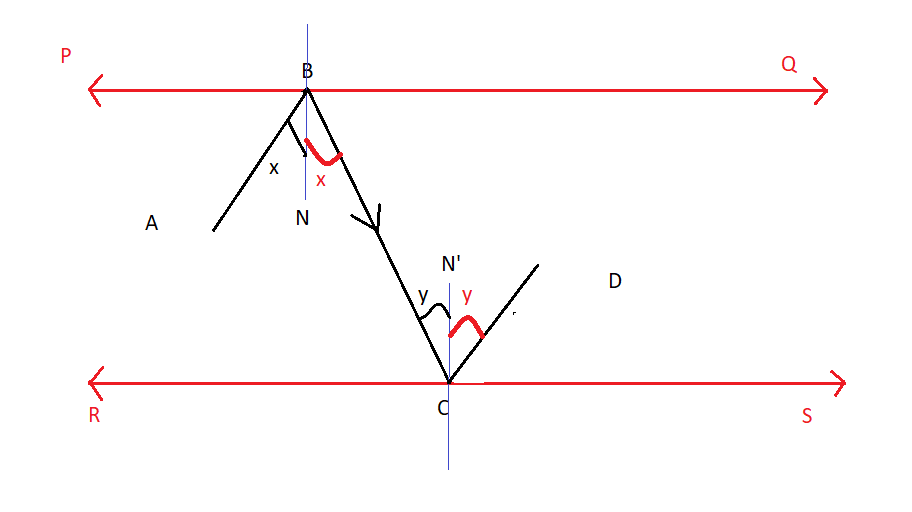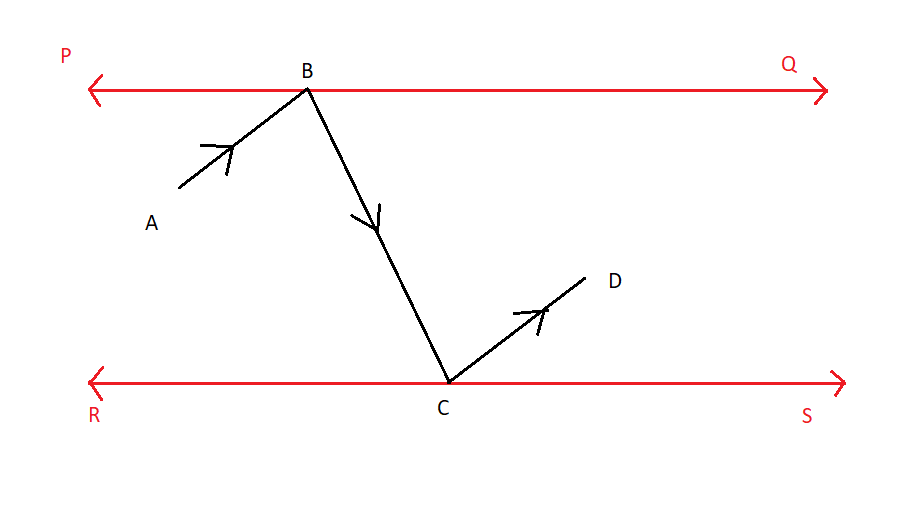
Answer
363.3k+ views
Hint: When any two parallel lines are intersected by another line called transversal, many angles are formed. These angles are related to each other and are equal, namely, corresponding angles, alternate interior angles, alternate exterior angles, and consecutive interior angles. So, to prove any two lines parallel we can make these angles equal.
Complete step by step solution:

Here we draw perpendicular \[BN\] and \[CN'\] on a mirror \[PQ\] and \[RS\] . \[PQ\] is a mirror. So, the angle of incidence is equal to the angle of reflection.
Therefore, $\angle ABN = \angle NBC$ ………………(1)
Similarly, \[RS\] is a mirror. Therefore,
$\angle BCN' = \angle N'CD$……………(2)
So, \[BN\] is parallel to \[CN'\] . Let us take \[BC\] as a transversal.
$\angle NBC = \angle N'CB$ alternate interior angle………………(3)
Now, considering equations (1), (2), and (3), we can write the following, using the figure.
$\angle ABC = \angle BCD$
Hence, we can say that \[AB\] and \[CD\] are parallel rays.
Note:
A mirror angle of incidence is always equal to the angle of reflection. This is due to the laws of reflection. Which also states that the angle of incidence, angle of reflection, and normal lie on the same plane.
A Transversal is a line that intersects the two lines at two different points. These two lines can be parallel or not. The angles formed are called corresponding angles and alternate angles.
Parallel lines are those which never intersect each other even when extended to infinity.
Complete step by step solution:

Here we draw perpendicular \[BN\] and \[CN'\] on a mirror \[PQ\] and \[RS\] . \[PQ\] is a mirror. So, the angle of incidence is equal to the angle of reflection.
Therefore, $\angle ABN = \angle NBC$ ………………(1)
Similarly, \[RS\] is a mirror. Therefore,
$\angle BCN' = \angle N'CD$……………(2)
So, \[BN\] is parallel to \[CN'\] . Let us take \[BC\] as a transversal.
$\angle NBC = \angle N'CB$ alternate interior angle………………(3)
Now, considering equations (1), (2), and (3), we can write the following, using the figure.
$\angle ABC = \angle BCD$
Hence, we can say that \[AB\] and \[CD\] are parallel rays.
Note:
A mirror angle of incidence is always equal to the angle of reflection. This is due to the laws of reflection. Which also states that the angle of incidence, angle of reflection, and normal lie on the same plane.
A Transversal is a line that intersects the two lines at two different points. These two lines can be parallel or not. The angles formed are called corresponding angles and alternate angles.
Parallel lines are those which never intersect each other even when extended to infinity.
Recently Updated Pages
Who among the following was the religious guru of class 7 social science CBSE

what is the correct chronological order of the following class 10 social science CBSE

Which of the following was not the actual cause for class 10 social science CBSE

Which of the following statements is not correct A class 10 social science CBSE

Which of the following leaders was not present in the class 10 social science CBSE

Garampani Sanctuary is located at A Diphu Assam B Gangtok class 10 social science CBSE

Trending doubts
Which are the Top 10 Largest Countries of the World?

Fill the blanks with the suitable prepositions 1 The class 9 english CBSE

How do you graph the function fx 4x class 9 maths CBSE

Find the value of the expression given below sin 30circ class 11 maths CBSE

In what year Guru Nanak Dev ji was born A15 April 1469 class 11 social science CBSE

The Equation xxx + 2 is Satisfied when x is Equal to Class 10 Maths

Why is there a time difference of about 5 hours between class 10 social science CBSE

Difference between Prokaryotic cell and Eukaryotic class 11 biology CBSE

What is BLO What is the full form of BLO class 8 social science CBSE





